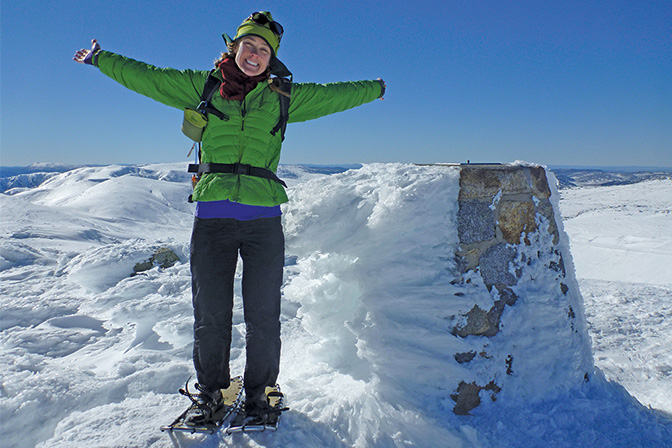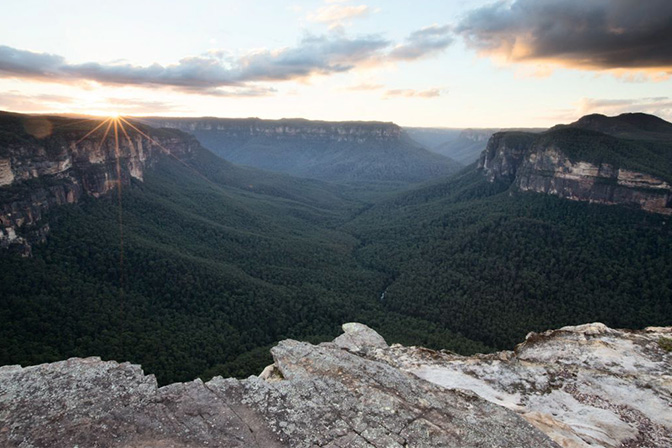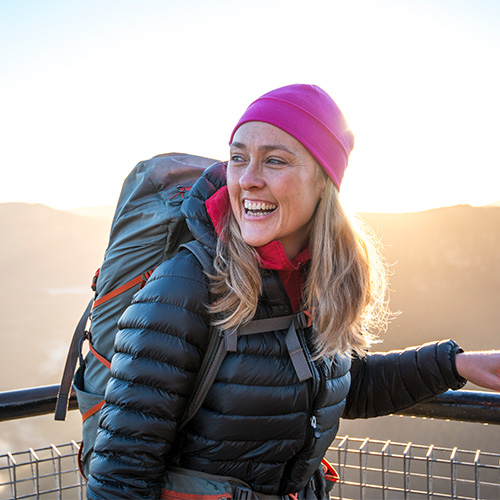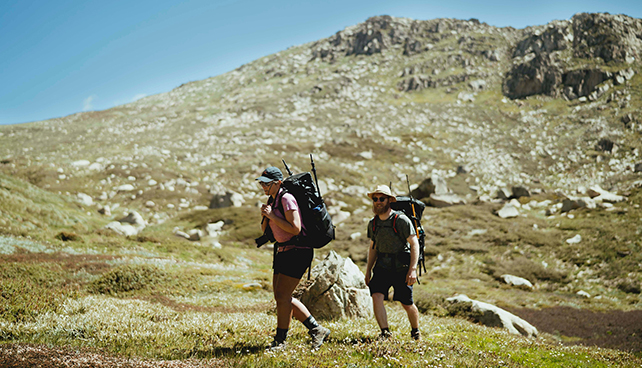
Winter means different things depending on where you live. In New Zealand, it’s time to get out the skis and snowboard, but in Australia it means one thing – time to go bush. Here’s Macpac Ambassador, Caro Ryan’s top 5 reasons why winter is bushwalking season in Australia.
After Autumn in the Blue Mountains (NSW) seemed to have gone AWOL, we finally look to be getting some chillier temps. This is the news that warms the cockles of every experienced bushwalker’s heart, because it means that yes, winter is coming. While summer holidays full of blissful Instagram filtered childhood memories in nature might be fondly looked back upon, the reality is that experienced and clued up Aussie bushies know that winter is where it’s at if you’re looking to go walkabout.

Caro Ryan on top of Mt Kosciusko
1. Not so sweaty Betty
One of the dangers of walking in the heat of an Australian summer is the increased risk of dehydration thanks to the amount of water your body expels during exercise by sweating. It’s not just the physical unpleasantness of feeling drenched on a thick, humid day (which, ironically, is our body trying to keep us cool), but dehydration can lead to heat related illness, which can be deadly.
When walking in winter, it’s easier to regulate your body temperature by adding extra layers, eating, drinking (warm drinks) and exercise. When you’re stuck out in the bush on a hot, humid day, miles from a water source, your options for temperature regulation are limited.
The truth is, winter is THE time of year to plan those extra challenging trips, the ones that will take more physical effort that you might even need to training for. If you’ve had your eye on a mountain to climb or a multi-day trip, winter is the time to take it on.
2. Pack lighter
It’s essential to carry sufficient water for every outdoor adventure that we embark upon. In summer, you need to carry a lot more, especially if you’re not going to be near reliable water sources. But did you know that each litre of water is a kilogram? That makes the thought of walking in cooler temperatures sound a lot more appealing. Sure, winter walking requires some extra layers of clothing for insulation, but as the weights for base and mid layers like merino, down and fleece are nice and light, you can hardly compare water and warmth when it comes to weight.
In winter, even though there’s less rainfall (isn’t that another reason to love winter walking?), you’re also more likely to find water in creeks and streams as the rate of evaporation is lower than it is in the summer months.
3. All the things that wanna kill ya
I just love the cheeky, wry, attitude that we have about some of our Australian wildlife. (Kiwis take note!) I’ve lost count of the number of times that I get asked if I’m scared about snakes and spiders in the bush, and frankly, I reckon this is a pretty poor excuse not to get out into wild places, especially in winter when they’re all snuggled up, snoozing underground until it’s warm again.
4. Opportunity to snuggle and toast
I don’t know if there is a better experience than kicking back in front of a campfire with good mates at the end of a long day bushwalking. Your body has a few aches (the good kind), your belly is full of tasty, warm, hearty camp food, you might have a mug of red wine beside you and you’re feet are warming in front of the ‘bush tele’. Conversation meanders, dad jokes are told and retold, and the plans for tomorrow’s journey are laid out.
The high fire danger days or TOBANS (Total Fire Bans) in summer can mean that it’s not just a dumb idea to have a fire (and in the case of TOBANS no stoves either), but illegal, too. Cold, dehydrated food anyone? I think not.
Just be sure to practice minimal impact when you do light a fire. It’s vital that you make sure you completely extinguish the embers and leave no trace of your campsite.

Photo credit: Rachel Dimond – Blue Mountains, Australia | The Log Book
5. Speaking of fires
With such a long, dry, bushfire season behind us, the knowledge of walking at a lower risk time of year is a big weight off the mind. Of course, it’s still important to check for alerts from local authorities like National Parks or your state’s Rural Fire Service, but the dangers are greatly reduced in winter.
The truth is, our bushwalking forebears, the legendary pioneers and map-makers of years gone by, knew that the cooler seasons were when the most adventures could be had. If you head out for a massive adventure in the heat of an Australian summer, you’ve not only got more chances of it turning into an epic misadventure, but will show yourself as a bit of an inexperienced numpty. And nobody wants that!
If you’re planning a winter bushwalk, make sure you check in with your state’s parks service for any track updates, weather warnings or extra pieces of info before you go. Here are the links for NSW, VIC, QLD, TAS, NT, WA, SA .


